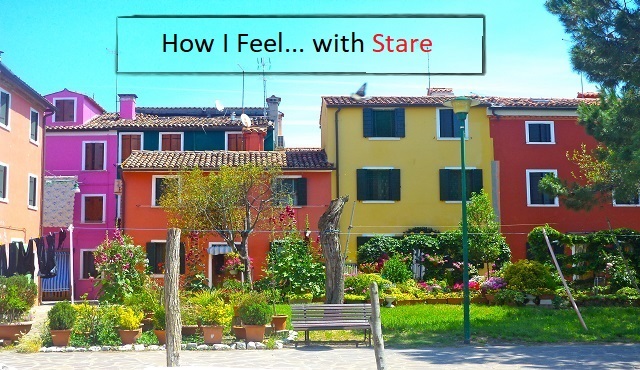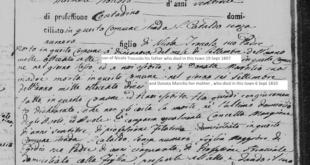The verb stare has an interesting history. Although the direct translation of stare is “to stay,” over the centuries, stare has also taken on the meaning of “to be” with respect to one’s general health.
Stare is an –are verb that has an irregular root in the tu and loro forms. In the table below, the regular conjugations of stare are given in green and the irregular forms in brown, in order to make them easier to recognize. Stare is a verb that will truly be used every day, so each conjugation should be committed to memory.
Stare – to stay (to be)
|
io |
sto | I stay/(am) |
| tu | stai | you (familiar) stay/(are) |
| Lei
lei/lui |
sta | you (polite) stay/(are)
she/he stays/is |
| noi | stiamo | we stay/(are) |
| voi | state | you all stay/(are) |
| loro | stanno |
they stay/(are) |
As most of us learn early on in our Italian studies, the familiar greeting, “How are you?” originates with the verb stare.
“Come stai?” is used with family and friends and “Come sta?” with acquaintances.
Let’s use our conjugations in the table above and describe in general if we are feeling well (bene) or badly/sick (male).
Stare bene – to feel well
| io | sto bene | I am well |
| tu | stai bene | you (familiar) are well |
| Lei
lei/lui |
sta bene | you (polite) are well
she/he is well |
| noi | stiamo bene | we are well |
| voi | state bene | you all are well |
| loro | stanno bene | they are well |
Stare male – to feel badly/sick
| io | sto male | I feel badly | I am sick |
| tu | stai male | you (familiar) feel badly | you (familiar) are sick |
| Lei
lei/lui |
sta male | you (polite) feel badly
she/he feels badly |
you (polite) are sick
she/he is sick |
| noi | stiamo male | we feel badly | we are sick |
| voi | state male | you all feel badly | you all are sick |
| loro | stanno male | they feel badly | they are sick |
If you would like to change-up your answer a bit, and be more descriptive about how you feel, of course there are many other options than simply “well” or “badly.” The phrases listed in the table below describe general feelings, from the best to the worst.
Note that not all of the replies to “Come stai?” or “Come sta?” use stare.
If you really want to speak like a native Italian, choose one of the “-issimo” endings for your reply, which are very common in spoken Italian today. Or, choose “non c’è male,” which many superstitious members of my family use so as not to be too happy about things and bring on bad luck!
Also, it should be mentioned that in informal situations, it is very common to substitute “Come va?” or “How’s it going?” for “Come stai?” In this case, a simple answer would be,“Va bene,” for “It’s going well/fine.”
| Come stai? Come sta? |
How are you? Familiar/Polite |
| Sto benissimo! | I am feeling great! I am really well! The best ever! |
| Sto molto bene. | I am very well. |
| Sto bene. | I am well/fine. |
| Così, così. | So, so. |
| Non c’è male. | Not so badly. |
| Sto male. | I am feeling badly/sick. |
| Sto molto male. | I am feeling very badly. I am very sick. |
| Sto malissimo! | I am very feeling very badly. I am really sick! I am feeling the worst ever! |
| Come va? | How’s it going? |
| Va bene. | It’s going well/fine/good/OK. |
To take this one step further, there is an important a part of the ritual of Italian greetings that should be followed. After stating how you feel, you should add a quick thanks and an inquiry into the the health of another.
For instance, “Sto bene, grazie. E tu?” or “E Lei?” for “I am well, thank you. And you? How are you?”
Or, if you know an individual’s family, it is considered polite to ask about them: “E la famiglia, come sta?” “And how is the family?
We can also use stare in many common expressions to tell someone else how we would like them to feel or even how to behave. In Italian, when we direct someone to do something, we must use the command form of a verb. For our purposes here, we will only discuss the familiar command forms of stare, which will be the same as the present tense tu and voi forms we have just reviewed. A negative command is given in the infinitive form in both Italian and English.
We can use stare to ask someone to remain calm (calmo), to be still (fermo), to be careful (attento) or to be silent (zitto). Remember to change the ending of each adjective to reflect the gender of the person who is being addressed.
A command is usually clear from the tone of voice when any language is spoken. In written Italian and sometimes in English, a command is generally followed by an exclamation point.
| Stare calmo(a)(i,e)! | to be calm/to remain calm |
| Stare fermo(a)(i,e)! | to stay still/to keep still |
| Stare zitto(a)(i,e)! | to be silent/to be quiet |
| Stare attento(a)(i,e)! | to be careful/watchful/pay attention |
Some example sentences are given below. How many more can you think of from your daily life?
If you’d like, leave some examples in the comment section.
Annina, stai calma! Non piangere più!
Little Ann, calm down! Don’t cry any more.
Non muoverti! Stai fermo, Giovanni!
Don’t move (yourself)! Stay still, John!
Sono le undici di sera. Stai zitto! I miei genitori stanno dormendo.
It is 11 o’clock at night. Be quiet! My parents are sleeping.
State attenti quando scendete dal treno!
Be careful when you all get off the train!
By the way…
In order to ask someone to keep quiet in a rude way, or as we would say in English, “Shut up!” you can use the Italian expression,“Chiudi il becco!”
And if you want to use the expression “shut up” to mean, “You’ve got to be kidding me!” or “You don’t say!” there are several interjections to choose from in Italian: “Ma dai!” “Non mi dire!” or “Ma non mi dire!”
I guarantee you will use this verb every day!
 Fra Noi Embrace Your Inner Italian
Fra Noi Embrace Your Inner Italian







